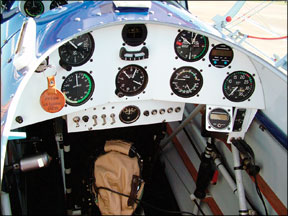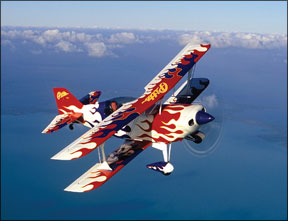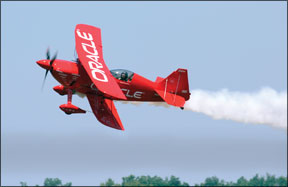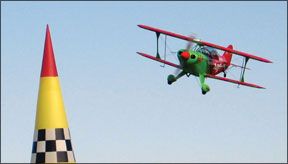In many ways, the Pitts Special is responsible for the current state of amateur and professional aerobatics. First flown in 1944 (or 1945-sources vary) as a single-seat homebuilt with only a 55-HP engine, the type has developed into todays highly refined and FAA-certified, two-seat, 300-HP aerial hot rod used for advanced training and-at least in lower categories-competitive aerobatics. Many different variants have evolved over the years, including factory-built and experimental versions, but there remain two main types: a single-seater and a two-holer. Today, you can buy a new, factory-built machine from certificate holder Aviat Aircraft, or get the plans and components for a single-seat version from Steen Aero Lab.
Dominant in aerobatic competition during the 1960s and 1970s, the Pitts Special long ago ceded that position to more-modern monoplane designs from Extra and Sukhoi. Even Pitts himself saw the monoplane light: Before his death in 2005 at age 89, he designed but never built the Model 13, an enclosed “coupe.” But the basic biplane design of the Special remains popular as a recreational and training aircraft, and still can be seen strutting its stuff at airshows, fly-ins, pancake breakfasts and private hangars throughout the world.
Its not for every pilot, of course. Its small stature, dictated by the need to keep things light and strong, means a short fuselage and stubby, relatively highly loaded wings when compared to most other personal airplanes. All of which results in an airplane responsive to the slightest control input, whether on or off a runway. If youre looking for a one- or two-seat cruiser, look elsewhere. On the other hand, if youre looking for an airborne toy, something to both challenge and perfect your skills, youve come to the right place.
History
The S-1 (single-seat) and S-2 (tandem seating for two) Pitts Special is the brainchild of Curtis Pitts, a designer and cropduster, who envisioned the airplane as the first specifically designed for aerobatics, according to the International Council of Air Shows Foundation. From the start, Pitts focused on keeping his creation small and light, something distinctly at odds with the much larger, radial-engined and war-weary biplanes then popular. By keeping things smaller than the norm, Pitts could incorporate a relatively underpowered flat engine and still obtain excellent performance.
Despite the Specials enduring popularity, Pitts also designed several monoplane types. But the biplane design-affording double the aileron capability in most variants-offered the greatest strength and lift in a smaller package.
The first Pitts Special to achieve notoriety was Lil Stinker, flown by aerobatics legend Betty Skelton, to three consecutive U.S. Female Aerobatic Championships, in 1948, 1949 and 1950. At the time, all Pitts Specials were built by Pitts and it wasnt until 1960 that plans were offered.
The first Pitts Special one could build in a garage or hangar was the S-1C, characteristics of which included a flat-bottom wing, bungee-cord landing gear, two ailerons and a single seat. It was powered by pretty much anything its builder wanted to hang on the front, from 85-HP Continentals to 200-HP Lycomings. According to Steen Aero Lab, which markets S-1 plans and components, the S-1C is the “benchmark” version. “Nearly all homebuilt S-1s used S-1C plans for the fuselage and tail, with supplemental wing plan options,” according to the company.
Soon, variants began coming out of Pitts shop, with differences mainly resulting from tinkering with horsepower, fixed or constant-speed props, and flat-bottom or symmetrical wings. Homebuilders also incorporated their own changes, resulting in a wide range of versions.
These include the S-1D (S-1C with a slightly stretched fuselage and four ailerons), S-1E (a homebuilt) and the S-1S (Commonly known as the “roundwing” Pitts, it was certified in 1973 and features symmetrical airfoils, four ailerons and a different upper-wing design enabling it to stall first).
One result of Pitts refusal to leave we’ll enough alone was the S-1-11B, or Model 11, also known as the Super Stinker. Still a single-seater, it featured a 300-plus-HP Lycoming, four ailerons, and a symmetrical airfoil (better for inverted flight than the flat-bottom version), and was available as either a factory-, plans- or kit-built airplane (the S-1SS). The S-1T, a certificated, production version, replaced the S-1S in 1981, according to Steen Aero Lab. It came with a 200-HP Lycoming, constant-speed prop and redesigned ailerons.
There’s even an “Ultimate” version, with full-width ailerons.
Meanwhile, a two-seat version was developed and included four ailerons and a symmetrical airfoil. The prototype S-2 had a 180-HP engine; production airplanes, designated S-2A, came with 200 ponies. Soon, the S-2C came on the scene, with 260 HP and featuring improved ailerons and rudder.
Of all the models and variants developed over the years, many remain available. For example, Aviat Aircraft still offers the S-1T (manufactured on-demand), S-1-11B (plans-completion only), and S-2C (260 HP), although one or more models may only be available by special order.
Despite the S-1/S-2s popularity, additional Pitts versions were developed. The Model 12, the last design built and flown by Curtis Pitts, is a slightly larger two-seat biplane specifically designed to use the Russian Vedeneyev M14P/PF radial engine of 360-400 HP. Its available as a factory-, plans- or kit-built aircraft.

Finally, Steen Aero Lab is developing the Pitts Model 14, which the company bills as “a leading-edge two-place aerobatic biplane.” Like the Model 12, its designed around the 400-HP Vendenyev M14PF nine-cylinder radial.
Handling
A Pitts is about as small as a biplane can be and still carry two people, fuel and a large engine. Some owners, however, point out that filling both seats creates weight-and-balance problems, especially if you intend aerobatics. And who wouldnt?
Both basic models are exceedingly clean and, to put it mildly, go like crazy. Its hard to believe that a few years ago these were considered near the best in world competition, but are now being used for primary training for those moving up to the Extra or Sukhoi.
The controls are we’ll harmonized. For one who came up in acro flying an Aerobat or Citabria, the overwhelming feeling is its only necessary to think about a maneuver to fly it. Most of those pilots overcontrol their Pitts the first time out. For one accustomed to running out of speed in the vertical almost instantaneously in a Citabria, the Pitts is a revelation.
But for all the delights it brings once airborne, visibility on landing is awful and the airplane is just plain hard to land. Our review of the types safety record (see sidebar on page 30) confirms this, with many NTSB probable cause statements reading something along the lines of, “The failure of the pilot to maintain directional control during the landing rollout.”
Of course, this should surprise no one: Take a look at the short fuselage, small tailwheel and relatively narrow main gear. Then decide how you’ll see the runway in front of the airplane when its in the three-point position. Its essential to get a good checkout before you fly the airplane home, or you run a significant risk of tearing it up on your first couple of landings. Its also essential to leave at home any tricycle-gear habits and remember to perform S-turns while taxiing.
Anyone moving up to a Pitts also should become proficient in performing forward slips as an energy management technique, since the type lacks wing flaps. And, although the S-2Cs published “clean” VS1 stall speed is a seemingly benign 56 knots, its a few knots higher than the VS0 “dirty” stall speed of high-performance singles like the Bonanza and Cessna Centurion.
Is the Pitts a handful? Those who have fallen in love with it emphatically say, “No!” Pitts guru Budd Davisson, for one, says he can teach anyone to land a Pitts. “The Pitts Specials reputation for being a handful on the ground is grossly exaggerated,” he adds. Davisson offers a transition course for aspiring Pitts pilots, estimating around 8-10 hours stick time for someone with a tailwheel endorsement, but admits the time required can “vary all over the block and is impossible to predict.”
Maintenance/Inspection
With fixed conventional landing gear and few avionics or instruments, a typical Pitts

Special is about as simple as airplanes get. The airframes are fabric-covered steel tubing, with a plywood torque box joining the wing spars.
In addition to the standard aerobatic airplane pre-purchase checklist, look for slop in the control system. It often just requires an adjustment but bearings can be worn out. Any Pitts flown regularly for aerobatics should be inspected frequently. Make sure the inspection holes have been cut in the underside of the wings, indicating someone is looking at the structure.
Once the wings are bolted together, the upper and lower wings form a rigid unit, so an impact to the lower wing may result in damage to the upper. Its essential to inspect each wing. Look to see if the spinner and nose bowl line up. If not, the bushings on the engine mounts are worn and are allowing the engine to sag. While this is initially cosmetic, it can result in the alternator being pushed into the nose bowl and the exhaust hitting the front of the firewall as we’ll as crushing the air box.
According to Budd Davisson, “There’s an easy way to tell if a Pitts has been subjected to extremely hard aerobatics outside of its design envelope. The most highly stressed part of the airplane is the anti-drag wire inside the top wing in the first bay outboard of the center section. The back ends of those wires go through the rear spar and come out inside the fabric area either side of the handhold behind the rear spar. If the airplane has been flown too hard, chances are there will be damage where the wires nut sits on top of the block thats glued to the rear face of the rear spar (just inboard of the root rib).”
The engine and prop might demand some extra inspection time, especially if your mechanic isn’t familiar with an aerobatic engine installation. Many Pitts may come with a smoke generator, another oddity for the average mechanic.
Of course, the covering on any fabric airplane should be considered suspect, especially if the example hasnt been hangared. Any ownership budget should set aside some dollars to recover the airplane at the appropriate time.
Finally, and while were not aware of any systemic corrosion issues with the steel tubing in a Pitts, the prudent purchaser is always on the lookout for related issues.
Pricing/Modifications
Although the Aircraft Bluebook Digest doesnt track the Pitts Special, the old standby-Trade-A-Plane-does. A recent issue included examples of S-2Bs: a 1985 with 510 total hours and some avionics, advertised for $79,000, and a 1986 model with 580 total hours, a new three-blade MT prop, smoke generator and “many extras” going for $95,000. The same Trade-A-Plane issue included a 1999 S-2C with only 120 hours at $185,000 and a project S-1C-“needs engine work”-for $24,000/obo.
As a pure sport airplane, Pitts modifications are usually designed to improve some aspect of the types handling or maintenance. Items like clear, Lexan floor panels, smoke generators, Haigh locking tailwheels (admired by new Pitts pilots; less-so by old sticks) and spring steel gear (to replace the older bungee-cord design) are popular mods. Other add-ons or replacements, depending on the aircrafts age, include inverted fuel and oil, electrical systems, Ceconite fabric coverings, seat-bottom parachutes and new, five-point harnesses.
Type Clubs/Support
Were not aware of a type club devoted to the Pitts Special, unless you count the various national and international organizations devoted to aerobatics. While not

type clubs per se, they are populated with pilots who have flown-and may still fly-the Pitts and have a thing or two to share. The local Experimental Aircraft Association chapter would be another great resource, especially for a kit- or plans-built example.
But owing in part to the airplanes diminutive size and small parts count, even a plans-built Pitts owner should have no trouble obtaining support via the various manufacturers continuing to build new, certificated aircraft (Aviat Aircraft, www.aviataircraft.com, 307-885-3151), kits, plans or a factory-built Model 12 (Jim Kimball Enterprises, www.pittsmodel12.com, 407-889-3451) or the documentation and components necessary to build an S-1 (Steen Aero Lab, www.steenaero.com, 321-725-4160).
The ultimate aficionado, however, is the aforementioned Budd Davisson, whose Web site (www.airbum.com) includes substantial resources for the pilot merely wanting to learn more about Mr. Pitts Specials or needing detailed information on which one to choose and how to fly it.
Owner Comments
I live in the U.K. and I have owned a Pitts S-2A for 15 years. It was built in 1981. It is a fantastic little two-seat aeroplane and a joy to fly. I do about 50 hours a year.
I have done lots of aerobatics in it over the years and, although I am no expert, aero is fairly easy and the aircraft has never yet “bitten” me. (There is always a first time of course and one has always to stay on top of it.)
I have also toured Europe extensively with trips to/from Italy, Spain, France, Belgium, Holland, Germany, Ireland, Scotland and the Channel Islands. I cruise at 120 knots and the range, leaning to nine gph, is 2.5 hours, no reserve.
I plan a maximum of two hours which is quite enough for the bladder and the backside, and that gets me 276 miles per leg.
Costs? Now this will shock you Americans. Each year, insurance runs 1200, hangar 2400, annual inspection approximately 1000, and 50 hours of fuel is 2340. The total for 50 hours of flying is 6940. In U.S. money, that works out to about $13,880 a year, or $276/hour.
Dave Cockburn
England
I have owned a 1983 Pitts S-2B and a 1991 Pitts S-1T, competing in Sportsmen through Unlimited category aerobatic contests. Having flown Decathlons, Extras, Sukhois, and several warbirds, I can say that there are a few points that stand out with Pitts aircraft. When flown within their limits, they are incredibly durable and economical to own. The landing gear is more robust than on any comparable aircraft, allowing a damage-free 10-foot drop test. Off-airfield emergency landings have proven to be more survivable in a Pitts than other light aircraft due to the “roll cage” of the top wing: I witnessed a Pitts S-1T hit a runway light at 80 mph and cartwheel to a stop. The pilot had but a scratch on his forehead.
Pitts have had their flight characteristics more studied and understood than any other types. These aircraft are some of the best teachers I have ever had the pleasure of flying. Fly regularly and you will soon find the landing phase immensely pleasurable and your favorite choice for tackling a 20-knot crosswind. Any Pitts will happily do most maneuvers from cruise power and cruise speeds. Control harmony is second to none. Low-time pilots will need to fly more than once a week to stay ahead of this plane. 10 touch and goes in 10 minutes using a 1000ft AGL pattern altitude with a tire chirp each time around is standard fare. If you fly less than once a week, get a Decathlon.
Flying an S-1T in Unlimited category, I had to use all +6/-4.67 G and 203 mph Vne many times a flight for hundreds of practice flights with no visible wear on the airframe. The key to a Pitts longevity is to never snap roll over 140 mph.
I sold my Pitts S-2B because of the dirty little Pitts secret: Fill the two seats and you will be over the aerobatic gross weight, the gross utility weight (1700 lb), and be aft CG. As a student at a flight school that teaches in S-2Bs, I experienced how two 215-lb. pilots with chutes and full fuel could recover from all spin modes quickly at this overloaded and aft CG loading. Add 550 lb. to the average empty weight of 1215 lb. and you are 65 lb. over-gross. This caused me to go look at an Extra 300L (>600 lb. useful load) and a Sukhoi SU29 (950 lb. useful load) to be legal with two people. The Pitts S-2C weighs in at 1260 lb. for the average delivered base aircraft and has the same Utility gross weight as the S-2B.
If you fly frequently and want an economical aerobat that will take you up through learning Unlimited aerobatics, an S-2B with a three-blade MT has proven to be the best bang for the buck. Two cautions: Canopies are fragile. The chap who bought my S-2B blew the canopy off on his first flight and concocted the first air show act with a skydiver who would fall out at the top of a loop. Secondly, complete spin training is a requirement. They are designed to recover almost instantly from any spin, including “hands-off”, but will also enter a spin quickly when a ham-footed pilot tries to skid around a slow base to final turn.
If you want a low-time S-2B without damage history, be ready to pounce on the first one you find. The resale is quick. The good ones tend to be sold in a week. This is one of the few airplanes that can maintain the same level of challenge and enjoyment, even after 1000 hours of play.
Rick Volker
Niagara Falls, N.Y.


